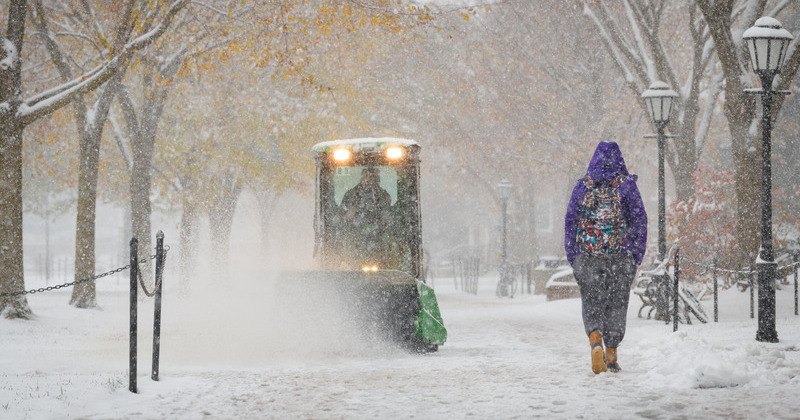


Winter weather procedures
Photo by Evan Krape January 16, 2024
How and when UD evaluates the weather and shares decisions with the campus
As temperatures get cooler, the University of Delaware Office of Emergency Management (OEM) shares important information about the process used for evaluating the need for delays and/or the need for suspended operations of the University.
This article is designed to help the campus community understand how and when a winter closure decision is typically made, and the communication channels that are used to share important weather-related information. An important fact to remember is the use of the word “closure” does not truly mean the University is closed. University personnel are on campus and providing critical services, such as public safety, health services and snow-plowing, as well as providing students with housing and dining services.
How a decision is made
Safety for students, faculty and staff is the primary consideration for any decision to close or delay classes and University operations. Factors that will be evaluated include road and sidewalk conditions on campus and the surrounding region. Typically, the UD Grounds Department has crews working in the early morning hours to clear University roads, parking lots, and sidewalks. Other factors that are evaluated include the weather predictions by the National Weather Service; announced state, county and local government closures; regional higher education and K-12 school district closures; and any existing State of Delaware or City of Newark driving restrictions.
Predicting weather in the Mid-Atlantic states is often quite challenging, especially when predicting snow accumulations. Weather conditions and forecasts can change significantly within a matter of hours because of slight variations in storm track and intensity. The University evaluates a variety of forecasting models to make the decision, but those weather changes may mean the storm is stronger or weaker than when the initial University decision is made.
When a decision is made
OEM staff will start to monitor weather conditions up to 72 hours in advance of any indication that winter weather may impact the region. If there is an indication that the weather may impact University operations, the Office of Communications and Marketing will post information through a variety of channels. These include the UD homepage and social media.
University leadership will discuss contingency plans and the potential need for a delayed opening or a closure. If necessary, a conference call will be convened with a variety of University leaders to discuss all factors and to make a decision on any potential delay or closure. Information about a delayed start or suspension of certain university services is typically announced by 6 a.m. on the impacted day. A change to University operations is made to ensure the safety of all individuals and to allow University personnel time to clear roads, parking lots, and sidewalks of any accumulated precipitation.
For any delay or closure, information will be communicated as quickly as possible.
Early release during the workday
If severe weather impacts the University during normal business hours, a similar protocol is followed in evaluating the need for an early release of University employees. Winter weather (especially freezing rain and sleet) can quickly develop resulting in a rapid deterioration of road conditions. In these cases, the Office of Communications and Marketing and OEM will use all means available to communicate any early release decision.
What to do during a delayed start or closure
If there is a delayed start to University operations, any class that is scheduled to start before the campus is open will be canceled. For example, with a 10 a.m. delayed start, any class that starts at 9:25 a.m. is canceled for the day. If there is a closure, all classes will be canceled or moved virtually from the time the closure takes effect until the University announces the resumption of full operations.
Your safety and University policy
Weather in Delaware can vary widely within a relatively short distance and, thus, the decision to drive to campus is always at the discretion of the individual.
Members of the University community are reminded that safety is UD's highest priority. Students and employees should not put themselves at risk. Students who are unable to get to campus because of the weather should contact their professors. Employees who expect difficulty traveling should contact their supervisors.
Weather communications: Your sources for information
News of campus-wide weather-related suspension of operations (or similar), late openings, or early release from campus, information will be available in a variety of ways:
on the UD home page (www.udel.edu) and on UDaily;
via the University's LiveSafe smartphone application, which provides the option to receive email or text updates (To use this option, you must download the free app. For information on how to subscribe to LiveSafe, click here);
on the University's primary social media accounts: www.facebook.com/UDelaware and www.twitter.com/UDelaware, as well as www.facebook.com/UDelPolice and www.Twitter.com/udelpolice.
in an email to all members of the campus community;
on the state Department of Education's School Closings and Delays website, which includes an option for automatic notification (To use the notification option, you must subscribe to this service which is not maintained by UD); and
on local radio broadcasts.
“Winter weather is something we can all prepare for in advance. We have more technology available today to stay informed about emerging weather patterns and how we can plan for the associated hazards,” said Josh Kelly, Associate Director of Emergency Management at the University. “Take a few minutes to download the LiveSafe App and bookmark the University website and social media channels that will provide you with important real-time information.”
Contact Us
Have a UDaily story idea?
Contact us at ocm@udel.edu
Members of the press
Contact us at 302-831-NEWS or visit the Media Relations website

